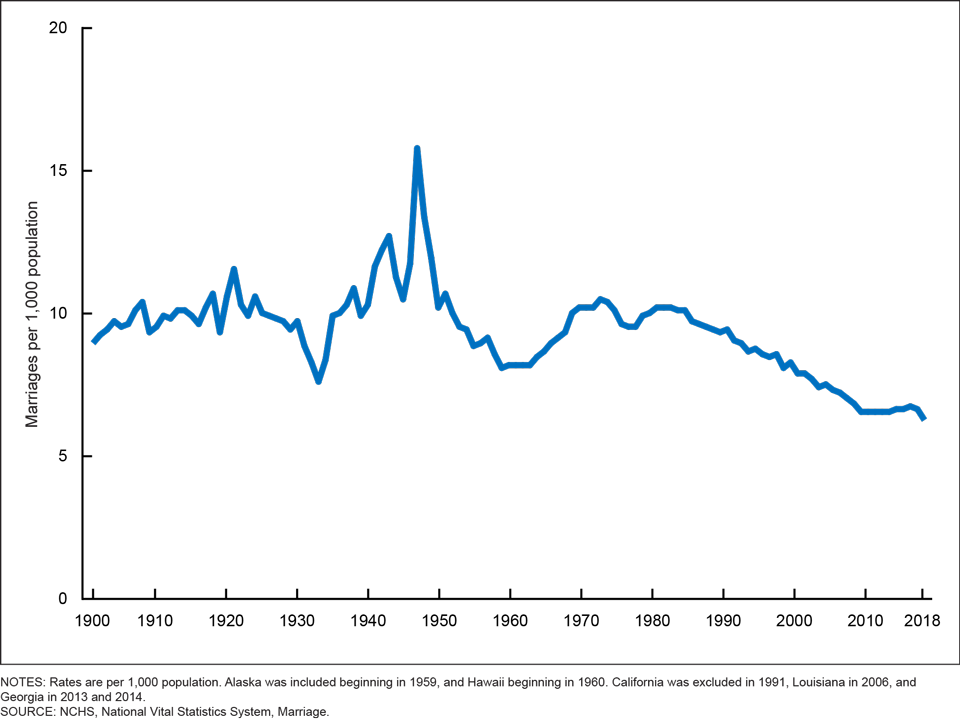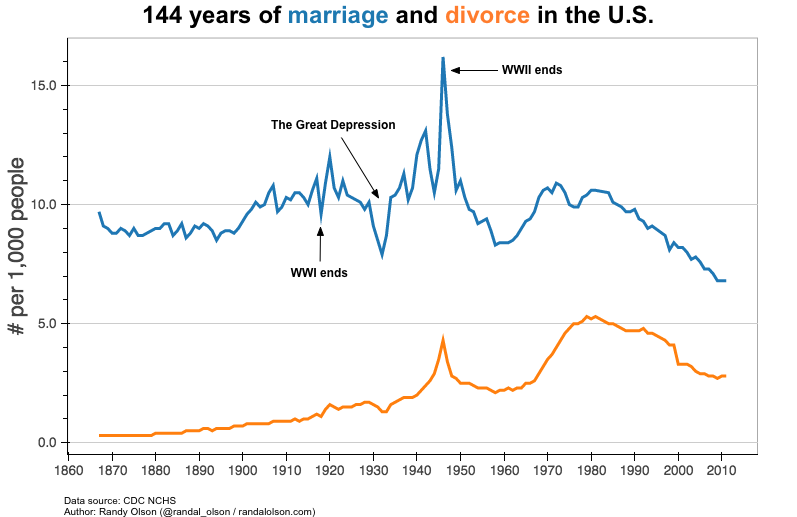According to the U.S. Census Bureau, new data shows that the United States grew at a slower rate in 2021 than any other year on record in the nation’s history. In the most recent estimates, the United States grew by just 0.1%, or by 392,665 people, which is the lowest rate since the nation’s founding.
While the Census Bureau states that the slow rate of growth can be attributed to decreased net international migration, decreased fertility, increased mortality due to an aging population, and the impact of the COVID-19 pandemic, I want to shed light on another unnamed factor. In my thorough research, I have discovered that litigated divorce in America has also contributed to the slowing population growth.

This finding also plays a role in the decreasing marriage rate in the United States. According to the latest data from the National Center for Health Statistics, a division of the Centers for Disease Control and Prevention (CDC), marriage rates have declined in recent years and trends show that they will continue to decline.
Decreasing Marriage and Population Rates
When looking at the data, it is clear that marriage rates and population growth go hand-in-hand. As more adults are foregoing marriage altogether, many are also choosing to not have children. The most recent numbers of marriage in America were published in 2018 and show a steady decline.

Specifically, as this graph shows, from 2017 to 2018, the rate dropped 6%, from to 6.9 per 1,000 population to 6.5 per 1,000. This is documented as the lowest marriage rate of the 1900—2018 period. Other data from the Census Bureau shows that in 2016, only 50% of Americans over the age of 18 were married. The CDC also notes that Americans are choose to postpone marriage. If they eventually marry, they may be past child-bearing age or forego having children.
Divorce and Marriage Rate Correlation
As I’ve researched in my book, The Cure for Divorce Culture, the culture of divorce in the United States is partly responsible for the decrease in marriage rates and the slowing population growth.
In order to fully understand this, I’d like to explain how the history of divorce has contributed to increasing divorce rates and decreasing marriage rates. In 1969, then-Governor Ronald Reagan signed the nation’s first no-fault divorce bill in California. Once this caught wind, divorce and family court became options through much of the nation. With this, divorce rates spiked in the 1980s. They continued maintain a steady rate through the 2000s and then eventually started to significantly decline.

The Census Bureau has studied this correlation before. According to data from the American Community Survey, in 2019, there were 16.3 new marriages for every 1,000 women (over the age of 15). This statistic is a decrease from the rate of 17.6 per every 1,000 women in 2009. Meanwhile, during this same period, divorce rates also decreased. In 2009, the divorce rate was 9.7 per 1,000 women (over the age of 15), yet in 2019, that rate fell to 7.6 per 1,000 women.
Children of Divorce and Marriage Rates
As divorce rates skyrocketed in the timeframe between 1980 and 2000, children of divorce became more common. These children were likely raised in separate homes, experienced family conflict, and were subjected to court and/or custody battles. Their experience with divorce as children has impacted them as adults. It may also impact them for years and generations to come.
As I’ve researched for my book, in cases of litigated divorce, adult children of divorce are:
- 200% more likely to get divorced when both spouses come from a divorced home
- 50% more likely to get divorced when one spouse is from a divorced home
Keep in mind that these high divorce rates are only for adult children of divorce who choose to marry. Many adult children of divorce stay single or choose not to marry. In fact, I know many adult children of divorce who are in happily committed relationships with significant others, but they choose to not marry. It makes sense that as marriage rates decline, the population growth hits an all-time low as well. As children of divorce in the 80s, 90s, and 2000s are now adults themselves, many are choosing to avoid the path that their parents took. In order to dodge a nasty and tumultuous divorce, they dodge marriage. In order to not put children through trauma and conflict, they choose to not have children.
In my own experience as a child of divorce, I am part of that statistic. My first marriage ended in divorce as my ex and I were both adult children of divorce. We married young and divorced just a few years later. Now, in my mid-30s, I married an amazing man who is from a loving family that never experienced divorce. We were thrilled to welcome our first child in 2021 and are honored to contribute to population growth in the United States. I share more details of my own personal journey in the most recent episode of my podcast, “Divorce, Healthy!” You can listen to this episode about curing the next generation and fixing divorce culture by clicking here.
Addressing Population Growth
During my career as an attorney, I have become an advocate for collaborative family law and out-of-court divorce processes because I have seen and experienced first-hand the negative effects of divorce litigation. This is especially true when children are involved. When divorce is handled in a controlled environment with respect and understanding, there is less conflict. It is a healthier experience for all involved, including the spouses’ children.
After years of steady decline, divorce rates are back on the rise. In a previous blog, I shared the reasons why and how the COVID-19 pandemic played a role in an increase of filings in the past couple of years. As more divorces are taking place, there could be more children who become part of the statistic. We need to spread awareness for alternative dispute resolution processes such as collaborative law, mediation, and negotiation so children and their parents can avoid the damaging effects of divorce litigation. If we, as Americans who are committed to a prosperous and thriving nation, can promote a healthier way to divorce, society will benefit. If there is a decrease in divorce handled with litigation, it is my hope that we’ll once again see a strong increase in population growth. It may take time, but it will be so worth it.
About AN|R Law
To learn more about working with AN|R Law: A Negotiated Resolution for divorce and other family law matters in North Carolina, please reach out to our office by calling 252-702-4376. We have four North Carolina locations in Raleigh, Greenville, Beaufort, and Wilmington to serve you and your family.
If you’re interested in learning more about this topic or inviting me, Ashley-Nicole Russell, to speak at your event or conference, I’d love to talk with you about the opportunity. I currently booking in-person and virtual speaking engagements for 2022. Please reach out to me by emailing media@anrlaw.com. I look forward to speaking with you.
